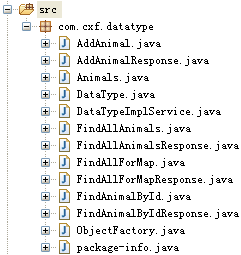4.CXF所支持的数据类型
前言:jdk提供了webService,但为什么使用jdk来开发webService相对少呢?
一个重要原因就是jdk支持的数据类型相对不足,例如Map就不为jdk所支持!
CXF支持的数据类型:
基本数据类型:
int、boolean、float等...
引用类型:
String、集合(Set、List、Map)、自定义数据类型...
补充说明:cxf支持所有的数据类型!
测试案例:
1.构建一个实体类Animals,为了测试基本数据类型,定义了三个属性,int型的id,String的name和float型的price
public class Animals {
private int id;
private String name;//动物名称
private float price;//动物价格
public Animals() {
super();
}
public Animals(int id, String name, float price) {
super();
this.id = id;
this.name = name;
this.price = price;
}
public int getId() {
return id;
}
public void setId(int id) {
this.id = id;
}
public String getName() {
return name;
}
public void setName(String name) {
this.name = name;
}
public float getPrice() {
return price;
}
public void setPrice(float price) {
this.price = price;
}
@Override
public String toString() {
return "Animals [id=" + id + ", name=" + name + ", price=" + price
+ "]";
}
}
2.编写SEI以及SEI实现类
@WebService
public interface DataType {
//添加一个动物
@WebMethod
boolean addAnimal(Animals a); //查找一只动物
@WebMethod
Animals findAnimalById(int id); //查找所有动物(测试List)
@WebMethod
List<Animals> findAllAnimals(); //查找所有动物(测试Map)
@WebMethod
Map<Integer,Animals> findAllForMap();
}
public class DataTypeImpl implements DataType {
@Override
public boolean addAnimal(Animals a) {
//为方便测试,直接返回true
return true;
}
@Override
public Animals findAnimalById(int id) {
return new Animals(1, "car", 50);
}
@Override
public List<Animals> findAllAnimals() {
List<Animals> list = new ArrayList<Animals>();
list.add(new Animals(1, "pig", 2000));
list.add(new Animals(2, "dog", 100));
list.add(new Animals(3, "duck", 40));
return list;
}
@Override
public Map<Integer, Animals> findAllForMap() {
Map<Integer, Animals> map = new HashMap<Integer, Animals>();
map.put(1, new Animals(1, "rabbit", 20));
map.put(2, new Animals(1, "chick", 30));
map.put(3, new Animals(1, "wolf", 20000));
return map;
}
}
3.发布
public class Publish {
public static void main(String[] args) {
String address = "http://localhost:8080/cxfServer";
Endpoint.publish(address, new DataTypeImpl());
System.out.println("如果发布成功,打印!");
}
}
4.使用cxf生成客户端代码

生成后的结构为:

5.查看wsdl文档
<?xml version='1.0' encoding='UTF-8'?><wsdl:definitions xmlns:xsd="http://www.w3.org/2001/XMLSchema" xmlns:wsdl="http://schemas.xmlsoap.org/wsdl/" xmlns:tns="http://datatype.cxf.com/" xmlns:soap="http://schemas.xmlsoap.org/wsdl/soap/" xmlns:ns1="http://schemas.xmlsoap.org/soap/http" name="DataTypeImplService" targetNamespace="http://datatype.cxf.com/">
<wsdl:types>
<xs:schema xmlns:xs="http://www.w3.org/2001/XMLSchema" xmlns:tns="http://datatype.cxf.com/" elementFormDefault="unqualified" targetNamespace="http://datatype.cxf.com/" version="1.0">
<xs:element name="addAnimal" type="tns:addAnimal"/>
<xs:element name="addAnimalResponse" type="tns:addAnimalResponse"/>
<xs:element name="findAllAnimals" type="tns:findAllAnimals"/>
<xs:element name="findAllAnimalsResponse" type="tns:findAllAnimalsResponse"/>
<xs:element name="findAllForMap" type="tns:findAllForMap"/>
<xs:element name="findAllForMapResponse" type="tns:findAllForMapResponse"/>
<xs:element name="findAnimalById" type="tns:findAnimalById"/>
<xs:element name="findAnimalByIdResponse" type="tns:findAnimalByIdResponse"/>
<xs:complexType name="findAllAnimals">
<xs:sequence/>
</xs:complexType>
<xs:complexType name="findAllAnimalsResponse">
<xs:sequence>
<xs:element maxOccurs="unbounded" minOccurs="0" name="return" type="tns:animals"/>
</xs:sequence>
</xs:complexType>
<xs:complexType name="animals">
<xs:sequence>
<xs:element name="id" type="xs:int"/>
<xs:element minOccurs="0" name="name" type="xs:string"/>
<xs:element name="price" type="xs:float"/>
</xs:sequence>
</xs:complexType>
<xs:complexType name="findAllForMap">
<xs:sequence/>
</xs:complexType>
<xs:complexType name="findAllForMapResponse">
<xs:sequence>
<xs:element name="_return">
<xs:complexType>
<xs:sequence>
<xs:element maxOccurs="unbounded" minOccurs="0" name="entry">
<xs:complexType>
<xs:sequence>
<xs:element minOccurs="0" name="key" type="xs:int"/>
<xs:element minOccurs="0" name="value" type="tns:animals"/>
</xs:sequence>
</xs:complexType>
</xs:element>
</xs:sequence>
</xs:complexType>
</xs:element>
</xs:sequence>
</xs:complexType>
<xs:complexType name="addAnimal">
<xs:sequence>
<xs:element minOccurs="0" name="arg0" type="tns:animals"/>
</xs:sequence>
</xs:complexType>
<xs:complexType name="addAnimalResponse">
<xs:sequence>
<xs:element name="return" type="xs:boolean"/>
</xs:sequence>
</xs:complexType>
<xs:complexType name="findAnimalById">
<xs:sequence>
<xs:element name="arg0" type="xs:int"/>
</xs:sequence>
</xs:complexType>
<xs:complexType name="findAnimalByIdResponse">
<xs:sequence>
<xs:element minOccurs="0" name="return" type="tns:animals"/>
</xs:sequence>
</xs:complexType>
</xs:schema>
</wsdl:types>
<wsdl:message name="findAnimalById">
<wsdl:part element="tns:findAnimalById" name="parameters">
</wsdl:part>
</wsdl:message>
<wsdl:message name="addAnimal">
<wsdl:part element="tns:addAnimal" name="parameters">
</wsdl:part>
</wsdl:message>
<wsdl:message name="findAllAnimalsResponse">
<wsdl:part element="tns:findAllAnimalsResponse" name="parameters">
</wsdl:part>
</wsdl:message>
<wsdl:message name="findAllForMapResponse">
<wsdl:part element="tns:findAllForMapResponse" name="parameters">
</wsdl:part>
</wsdl:message>
<wsdl:message name="findAnimalByIdResponse">
<wsdl:part element="tns:findAnimalByIdResponse" name="parameters">
</wsdl:part>
</wsdl:message>
<wsdl:message name="addAnimalResponse">
<wsdl:part element="tns:addAnimalResponse" name="parameters">
</wsdl:part>
</wsdl:message>
<wsdl:message name="findAllAnimals">
<wsdl:part element="tns:findAllAnimals" name="parameters">
</wsdl:part>
</wsdl:message>
<wsdl:message name="findAllForMap">
<wsdl:part element="tns:findAllForMap" name="parameters">
</wsdl:part>
</wsdl:message>
<wsdl:portType name="DataType">
<wsdl:operation name="findAllAnimals">
<wsdl:input message="tns:findAllAnimals" name="findAllAnimals">
</wsdl:input>
<wsdl:output message="tns:findAllAnimalsResponse" name="findAllAnimalsResponse">
</wsdl:output>
</wsdl:operation>
<wsdl:operation name="findAllForMap">
<wsdl:input message="tns:findAllForMap" name="findAllForMap">
</wsdl:input>
<wsdl:output message="tns:findAllForMapResponse" name="findAllForMapResponse">
</wsdl:output>
</wsdl:operation>
<wsdl:operation name="addAnimal">
<wsdl:input message="tns:addAnimal" name="addAnimal">
</wsdl:input>
<wsdl:output message="tns:addAnimalResponse" name="addAnimalResponse">
</wsdl:output>
</wsdl:operation>
<wsdl:operation name="findAnimalById">
<wsdl:input message="tns:findAnimalById" name="findAnimalById">
</wsdl:input>
<wsdl:output message="tns:findAnimalByIdResponse" name="findAnimalByIdResponse">
</wsdl:output>
</wsdl:operation>
</wsdl:portType>
<wsdl:binding name="DataTypeImplServiceSoapBinding" type="tns:DataType">
<soap:binding style="document" transport="http://schemas.xmlsoap.org/soap/http"/>
<wsdl:operation name="findAllAnimals">
<soap:operation soapAction="" style="document"/>
<wsdl:input name="findAllAnimals">
<soap:body use="literal"/>
</wsdl:input>
<wsdl:output name="findAllAnimalsResponse">
<soap:body use="literal"/>
</wsdl:output>
</wsdl:operation>
<wsdl:operation name="findAllForMap">
<soap:operation soapAction="" style="document"/>
<wsdl:input name="findAllForMap">
<soap:body use="literal"/>
</wsdl:input>
<wsdl:output name="findAllForMapResponse">
<soap:body use="literal"/>
</wsdl:output>
</wsdl:operation>
<wsdl:operation name="addAnimal">
<soap:operation soapAction="" style="document"/>
<wsdl:input name="addAnimal">
<soap:body use="literal"/>
</wsdl:input>
<wsdl:output name="addAnimalResponse">
<soap:body use="literal"/>
</wsdl:output>
</wsdl:operation>
<wsdl:operation name="findAnimalById">
<soap:operation soapAction="" style="document"/>
<wsdl:input name="findAnimalById">
<soap:body use="literal"/>
</wsdl:input>
<wsdl:output name="findAnimalByIdResponse">
<soap:body use="literal"/>
</wsdl:output>
</wsdl:operation>
</wsdl:binding>
<wsdl:service name="DataTypeImplService">
<wsdl:port binding="tns:DataTypeImplServiceSoapBinding" name="DataTypeImplPort">
<soap:address location="http://localhost:8080/cxfServer"/>
</wsdl:port>
</wsdl:service>
</wsdl:definitions>
6.测试(获取服务端各种数据类型的数据)
public class TestDataType {
public static void main(String[] args) {
DataTypeImplService factory = new DataTypeImplService();
DataType dataType = factory.getDataTypeImplPort();
boolean bool = dataType.addAnimal(new Animals());
System.out.println(bool);
Animals a = dataType.findAnimalById(1);
System.out.println(a);
List<Animals> list = dataType.findAllAnimals();
System.out.println(list);
Return r = dataType.findAllForMap();
List<FindAllForMapResponse.Return.Entry> entrys = r.getEntry();
for(Return.Entry entry : entrys){
int id = (int) entry.getKey();
Animals name = entry.getValue();
System.out.println(id+":"+name);
}
}
}
运行结果:
true
Animals [id=1, name=car, price=50.0]
[Animals [id=1, name=pig, price=2000.0], Animals [id=2, name=dog, price=100.0], Animals [id=3, name=duck, price=40.0]]
1:Animals [id=1, name=rabbit, price=20.0]
2:Animals [id=1, name=chick, price=30.0]
3:Animals [id=1, name=wolf, price=20000.0]
注意:
map的使用方法略不同,使用dataType.findAllForMap();后,返回的是个Return类,下面是Return类代码:
public class FindAllForMapResponse {
@XmlElement(required = true)
protected FindAllForMapResponse.Return _return;
public FindAllForMapResponse.Return getReturn() {
return _return;
}
public void setReturn(FindAllForMapResponse.Return value) {
this._return = value;
}
@XmlAccessorType(XmlAccessType.FIELD)
@XmlType(name = "", propOrder = {
"entry"
})
public static class Return {
protected List<FindAllForMapResponse.Return.Entry> entry;
public List<FindAllForMapResponse.Return.Entry> getEntry() {
if (entry == null) {
entry = new ArrayList<FindAllForMapResponse.Return.Entry>();
}
return this.entry;
}
@XmlAccessorType(XmlAccessType.FIELD)
@XmlType(name = "", propOrder = {
"key",
"value"
})
public static class Entry {
protected Integer key;
protected Animals value;
public Integer getKey() {
return key;
}
public void setKey(Integer value) {
this.key = value;
}
public Animals getValue() {
return value;
}
public void setValue(Animals value) {
this.value = value;
}
}
}
}
4.CXF所支持的数据类型的更多相关文章
- MySQL知识树-支持的数据类型
本篇学习笔记的主要内容: 介绍MySQL支持的各种数据类型(常用),并讲解其主要特点. MySQL支持多种数据类型,主要包括数值类型.日期和时间类型.字符串类型. 数值类型 MySQL的数值类型包 ...
- Cassandra在CQL语言层面支持多种数据类型
Cassandra在CQL语言层面支持多种数据类型. CQL类型 对应Java类型 描述 ascii String ascii字符串 bigint long 64位整数 blob ByteBuffer ...
- 【原创】C++链表如何像Python List一样支持多种数据类型
用过Python的码友都知道,Python中List支持多种数据类型,如下面代码所示链表li内的数据类型可以是整数,同时也可以是字符串,当然也可以是其他数据类型. 1: >>> li ...
- android sqlite支持的数据类型
Sqlite3支持的数据类型 :NULL.INTEGER.REAL.TEXT.BLOB 但实际上,sqlite3也接受如下的数据类型: smallint 16 位元的整数. interge ...
- Memcache仅仅支持简单数据类型
Memcache仅仅支持简单数据类型 ,复杂数据类型需要应用自己处理 从数据库当中取出数据[User [id=1, username=guowuxin, password=guowuxin], Use ...
- mysql支持的数据类型及其测试
原文:mysql支持的数据类型及其测试 1.基础知识 1.1如何来查看mysql的帮助手册 ?int Help float; 1.2创建表的规则 CREATE TABLE [IF NOT EXISTS ...
- MongoDB 所支持的数据类型 创建和删除集合 创建和删除数据库
数据类型 MongoDB 支持如下数据类型: String:字符串.存储数据常用的数据类型.在 MongoDB 中,UTF-8 编码的字符串才是合法的. Integer:整型数值.用于存储数值.根据你 ...
- 初识Redis系列之三:Redis支持的数据类型及使用
支持的数据类型有五种: string(字符串).hash(哈希).list(列表).set(集合)及zset(sorted set:有序集合): 下面分别对这几种类型进行简单的Redis存取操作 1: ...
- 数据库 -- mysql支持的数据类型
mysql支持的数据类型 数值类型 MySQL支持所有标准SQL数值数据类型. 这些类型包括严格数值数据类型(INTEGER.SMALLINT.DECIMAL和NUMERIC),以及近似数值数据类型( ...
随机推荐
- 使用PHP发送email进行账号激活或者密码修改操作
使用PHPMailer编写发送邮件 PHPMailer需PHP的socket扩展支持,而PHPMailer链接qq域名邮箱时需要ssl加密方式(qq邮箱最近做了限制,新开域名邮箱不再允许通过smtp协 ...
- jdk安装和环境变量配置
jdk的安装和环境变量配置每次换新环境都在做,但是每次都没有认真去想是怎么做的,反正每次打开百度搜索照做就是.这次整理一下,也顺便理清一下其中的原理. 1.第一步当然就是下载jdk,我这边下载的是jd ...
- Java的二维数组的应用及杨辉三角的编写
(1) 编写一个程序,生成一个10*10的二维随机整数数组,并将该数组的每行最大值保存于一个一维数组中,将每列平均值保存于另外一个一维数组中并分别输出. (2) 编程输出杨辉三角的前10行. 找出一个 ...
- 互联网商业模式O2O、C2C、B2B、B2C等介绍
O2O是online to offline分为四种运营模式: 1.online to offline是线上交易到线下消费体验 2.offline to online是线下营销到线上交易 3.offli ...
- 【Lua】Lua的几点优化原则
Lua是一门以性能著称的脚本语言,被广泛的应用在很多方面,比如很多游戏的插件. 很多时候,没有必要去考虑性能的问题,不过,如果我们在开始编写代码的时候就以更适当,性能更高的方式与结构去组织代码,对于程 ...
- ajax 异步加载显示等待效果
css: #loading { width:170px; height:25px; border:3px solid #C3DAF9; position:absolute; top:300px; le ...
- 深入理解Java虚拟机(一)、Java内存区域与内存溢出异常
Java虚拟机所管理的内存包括以下几个运行时数据区: 程序计数器(PCR): 1.是一块较小的内存空间,可以看做是当前线程所执行的字节码的行号指示器 2.为线程私有 3.执行Java方法有PCR,执行 ...
- Wind7系统下 wifi设置
netsh wlan set hostednetwork mode=allow ssid=pass:123456789 key=123456789 netsh wlan set hostednetw ...
- easyui datagird 列宽自适应
代码如下: onLoadSuccess: function (data) { var rows = data.rows; //得到行数据 var columnMaxCharacter = new Ar ...
- ArrayList与LinkedList用法与区别
1.ArrayList是实现了基于动态数组的数据结构,LinkedList基于链表的数据结构. 2.对于随机访问get和set,ArrayList觉得优于LinkedList,因为LinkedLis ...
